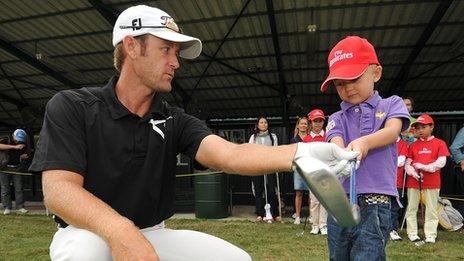US Open: Taking on controversial Chambers Bay course
- Published
- comments
Carter shows Johnson how to putt it
Iain tries out the public golf course that caused so much controversy at the US Open, and discovers it takes some "imagination".
Championship golf does not need to be played at ultra-exclusive high-end private clubs. That much became clear after a thrilling US Open at Chambers Bay.
The course is a public facility, like the Old Course at St Andrews, which will stage the next major, the Open, in July.
And the events in the Seattle environs where Jordan Spieth landed his second Grand Slam title have set up perfectly Rory McIlroy's title defence at the home of golf.
Spieth is closing in on the Northern Irishman at the top of the world rankings, external as he seeks to become only the second player to win the first three majors of the year.
The 21-year-old wants to emulate his fellow Texan Ben Hogan, who achieved the feat when he won the Open at Carnoustie in 1953.
Having won the Masters in April, Spieth claimed his first US Open title at the end of one of the most exciting weeks of major golf in recent times.
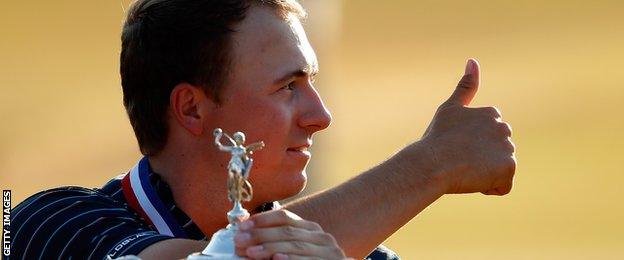
Spieth became the youngest US Open winner since Bobby Jones in 1923
It was a controversial championship, with so many players complaining about the state of the Chambers Bay greens and the links-style course on the Puget Sound.
For all the faults, particularly with the greens, the course served up a memorable tournament that culminated in a thrilling finish featuring many of the world's best players.
There can be no qualms about the course's ability to identify the most talented golfers. McIlroy, 26, was spot on when he said he thought it would separate the best from the rest.
The world number one set the tone for the final round with his charge up the leaderboard that had him flirting with contention until he bogeyed the par-three 15th.
A former world number one, Adam Scott, took up the baton with a sizzling 64 to set a challenging clubhouse lead at three under par.
Then came former Open champion Louis Oosthuizen's inward half of 29 to go one stroke better.
None of this would be have been possible had the course and its set-up been too severe.
US Open final leaderboard |
|---|
-5 J Spieth (US); -4 L Oosthuizen (SA), D Johnson (US); -3 A Scott (Aus), C Smith (Aus) B Grace (SA); -2 C Schwartzel (SA); -1 B Snedeker (US); Level R McIlroy (NI), S Lowry (Ire), J Day (Aus) |
Selected others: +3 S Garcia (Spa); +5 T Fleetwood (Eng), J Gunn (Sco), J Rose (Eng), M Warren (Sco); +6 P Casey (Eng); +9 L Westwood (Eng); +11 I Poulter (Eng); +12 L Donald (Eng) |
Those charges preceded the dramatic denouement when Dustin Johnson missed eagle to win as he three-putted to lose on the 72nd green.
So how was it possible for the big-hitting American to squander this opportunity of, at the very least, an 18-hole play-off for the title?
Well, even with personal experience, I can't tell you how fast was that 12-footer for eagle.
I played the course the following day and the greens were a tad slower than on the final afternoon of the US Open.
Naturally our fourball had a go at Johnson's putt. It was the most delicate of taps down the slope, borrowing from left to right.
While I got lucky and dropped my attempt into the cup I know that had it missed, it would have run considerably further than the three or four feet that Johnson's travelled before coming to rest.
It was impossible to leave the ball close to the cup if you were realistically trying to hole the 12-footer. And the key to putting those greens was a positive stroke because anything that dribbled towards the hole would never hold its line.
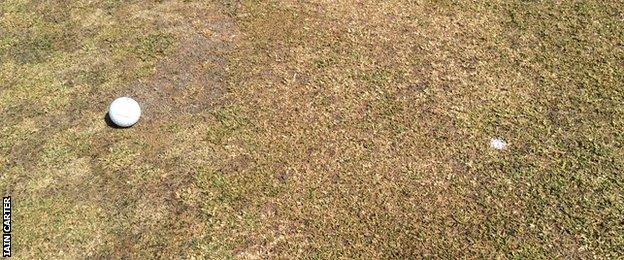
The Chambers Bay greens were heavily criticised by players during the US Open
Some of the greens were very poor. The fourth was particularly bad, with substantial bare sandy patches that had no grass at all.
Most had a camouflage colouring and pattern that couldn't hide considerable imperfections. Yet the 13th and the seventh, both recently re-laid, were excellent putting surfaces.
This suggests the US Open came too soon to a course that has only been open for eight years. If the other greens had received the care and attention lavished on the renewed surfaces there would have been few complaints.
But Gary Player's criticisms were over the top. Player, who completed a career Grand Slam by winning the US Open 50 years ago, said ordinary players couldn't enjoy such a course and that a 10 handicapper wouldn't break a hundred.
Well, playing off eight and not enjoying my best ball-striking day, I managed to sneak under that mark by a couple of strokes. We didn't play all the way back, but still took on a course measuring about 7,000 yards.
It was fun and it tested golfing imagination, using the contours to fashion the kind of approaches you would never normally take on.
US Open analysis: Iain Carter, BBC Sport golf correspondent |
|---|
"It was one of the great final days in major championship golf. It confirmed, if confirmation was needed, Spieth's superstar status. |
"He has proven himself in the vastly different environments of the Masters and the US Open. Now all four major titles lie in the hands of two men and there is no doubt golf is currently all about his rivalry with McIlroy. |
"For Johnson this will be the bitterest blow in a career that has also seen him lose winning positions in three other majors. He faces a mighty challenge to recover after three-putting his way out of a play-off." |
The biggest reservation was that the layout made it impossible for spectators to follow the action. That is inexcusable in a sport where a big part of the magic is sharing not just the theatre but the stage with the players.
But golf historians, quite rightly, will simply look at the champion it produced because Spieth has graduated to superstar status in the blink of an eye.
Now he's looking ahead to the next major at St Andrews. "The home of golf," Spieth acknowledged in the wake of this triumph.
"I've played one round at St Andrews when we were preparing for the Walker Cup at Royal Aberdeen.
"I remember walking around the R and A clubhouse and seeing paintings of royalty playing golf. It's one of my favourite places in the world and it was dated 1460-something.
"I'm thinking, our country was discovered in 1492 and they were playing golf here before anyone even knew the Americas existed," he added.

"Bunkers were good to play from as I found with great regularity. Rough much thicker than I anticipated, often penal. 36 putts, holed nothing"
Spieth doesn't plan any extra reconnaissance work before his assault on the third leg of the Grand Slam. He will play the John Deere Classic before flying over to Scotland to arrive on the Monday of Open week.
"I'm just focused on the Claret Jug now," he said. "I think that the Grand Slam is something that I never could really fathom somebody doing."
Tiger Woods held all four majors at one time, but not all in the same year. It was a 'Tiger Slam' that started with the 2000 US Open and ended with the 2001 Masters.
Spieth believes the Slam is doable this year. "This was somewhat of a British-style golf course, so are the next two majors," he said.
The PGA will be staged on the shores of Lake Michigan at Whistling Straits. Who knows? Spieth may go there with the first three majors in his bag.
But for that to happen he would need to dethrone McIlroy at St Andrews. This will surely inspire the world number one who has already won three times this year and respectably finished fourth and ninth in the first two majors.
The reigning Open champion will surely put up a fierce fight to retain the Claret Jug as well as his PGA title in August.
Golf always craves rivalries at the top of the game and with Spieth and McIlroy it now has one for us to savour, potentially for years to come.
- Published23 June 2015

- Published23 June 2015
- Published22 June 2015
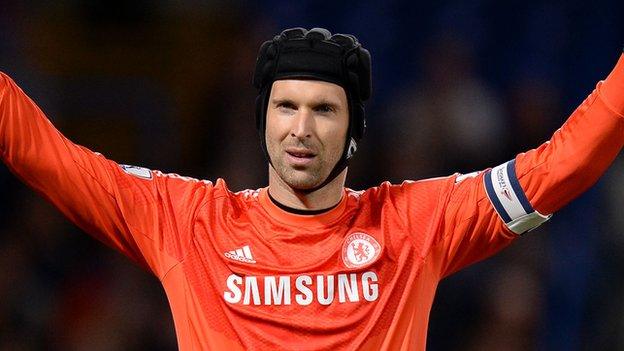
- Published22 June 2015
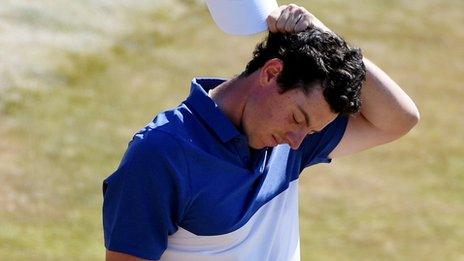
- Published19 July 2016

- Published28 September 2018
